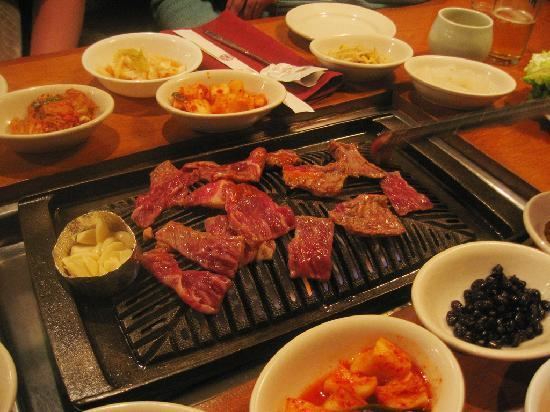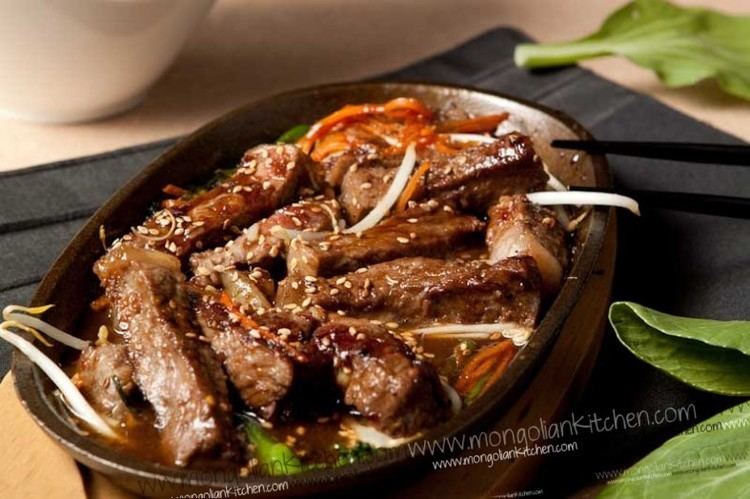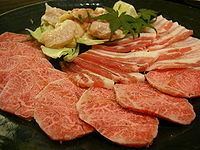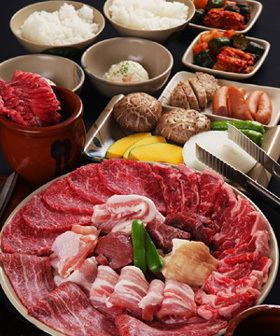 | ||
Similar Horumonyaki, Yakitori, Ramen, Galbi, Shabu‑shabu | ||
Deer dishes 14 tongue yakiniku hip steak
Yakiniku (焼き肉 or 焼肉), meaning "grilled meat", is a Japanese term that, in its broadest sense, refers to grilled meat dishes. "Yakiniku" originally referred to the "barbecue" of western food, which was given by Japanese writer Kanagaki Robun (仮名垣魯文) in his literature, Seiyo Ryoritsu (meaning "western food handbook"), in 1872 (Meiji period). Meat has been eaten in Japan since the Jōmon period. However, the rise of Buddhism made the eating of meat taboo and some people have theorized that meat "disappeared" from the table from the Middle Ages to the Edo period. The term "yakiniku" became associated with Korean-derived cuisine during the early Showa period. Due to the Korean War, Korean restaurants in Japan were divided into North Korean (Kita Chōsen) and South Korean (Kankoku); "yakiniku restaurant" arose as a politically correct term for restaurants of either type.
Contents
- Deer dishes 14 tongue yakiniku hip steak
- Japanese cooking yakiniku yakiniku japanese style barbecue recipe how to make japanese grilled meat
- Etymology
- Origin
- Typical ingredients
- Yakiniku Day
- References

Today, it commonly refers to a Japanese style of cooking bite-size meat (usually beef and offal) and vegetables on gridirons or griddles over flame of wood charcoals carbonized by dry distillation (sumibi, 炭火) or gas/electric grill. In North America, China, and Taiwan, yakiniku is also referred to as "Japanese barbecue" while in Japan the origin has become a subject of debate, though it is conventionally considered to be Korean cuisine. In 2002 the NHK program NHK Ningen Kouza (NHK人間講座, literally NHK Humanity Lecture) stated: "While some tend to think that yakiniku came from Korea, it was born in post war Japan." Yet there are those who say that while yakiniku may have its beginnings in Japan, they believe it was first made by Zainichi Koreans (long-term Korean residents) and should therefore be considered Korean cuisine.

Yakiniku is a variant of bulgogi that has been modified by Zainichi Koreans to appeal to Japanese tastes.
The present style of yakiniku restaurants are also derived from the Korean restaurants in Osaka and Tokyo which were opened around 1945.

In a yakiniku restaurant, diners order prepared raw ingredients (individually or as a set) which are brought to the table. The ingredients are cooked by the diners on a grill built into the table throughout the meal, several pieces at a time. The ingredients are then dipped in sauces known as tare before being eaten. The most common sauce is made of Japanese soy sauce mixed with sake, mirin, sugar, garlic, fruit juice and sesame. Garlic-and-shallot or miso-based dips are sometimes used. Korean side dishes like kimchi, nameul, bibimbap are served alongside.

Japanese cooking yakiniku yakiniku japanese style barbecue recipe how to make japanese grilled meat
Etymology
After officially being prohibited for many years, eating beef was legalised in 1871 following the Meiji Restoration as part of an effort to introduce western culture to the country. The Emperor Meiji became part of a campaign to promote beef consumption, publicly eating beef on January 24, 1873. Steak and roasted meat were translated as yakiniku (焼肉) and iriniku (焙肉), respectively, as proposed western-style menus in Seiyō Ryōri Shinan although this usage of the former word was eventually replaced by the loanword sutēki.

Jingisukan (ja:ジンギスカン, the Japanese transliteration of Genghis Khan), is a style of grilling mutton, which is also referred to as a type of yakiniku. The dish was conceived in Hokkaidō, where it has been a popular blue-collar dish that has only recently gained nationwide popularity. The name Jingisukan is thought to have been invented by Sapporo-born Tokuzo Komai, who was inspired by the grilled mutton dishes of Northeastern Chinese cuisine. The first written mention of the dish under this name was in 1931.
Origin
Common Japanese style of yakiniku, drawing influences from Korean dishes such as bulgogi and galbi, became widespread in Japan during the 20th century, most notably after the Second World War. Restaurants serving this dish either advertised themselves as horumonyaki (ja:ホルモン焼き, offal-grill) or simply Joseon (Korean) cuisine (朝鮮料理, chōsen ryori). The division of the Korean peninsula led to disagreements in the mid-1960s in the naming of "Korean food", with pro-South businesses changing their signs to "kankoku ryori (韓国料理)" (named after Republic of Korea) rather than retaining the term chōsen (Joseon), the name of the old, undivided Korea which by then had been appropriated by the North.
Ventilated barbecue systems, introduced by Shinpo Co., Ltd. in March 1980, quickly spread throughout Japan as it enabled diners to eat yakiniku in a smoke-free environment and greatly extended the clientele.
The popularity of yakiniku was given a further boost in 1991 when the easing of beef import restrictions led to a drop in the price of beef. However, the industry was dealt an unprecedented blow in 2001 with the occurrence of BSE (mad cow disease) in Japan.
Typical ingredients
Typical ingredients include:
Yakiniku Day
In 1993, the All Japan Yakiniku Association proclaimed 29 August as official "Yakiniku Day" (yakiniku no hi), a form of goroawase (numerical wordplay), as the date 8月29 can be (roughly) read as ya-(tsu)ki-ni-ku (8 = ya, 2 = ni, 9 = ku).
